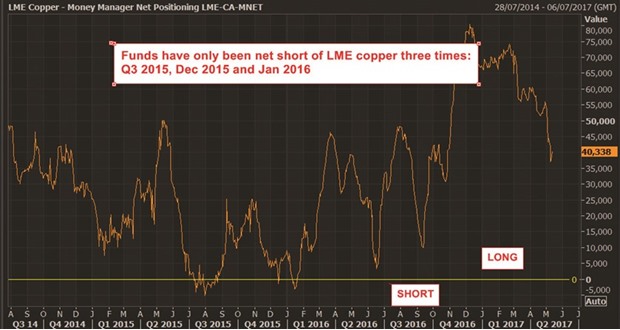The London Metal Exchange (LME) started publishing its Commitments of Traders Report (COTR) in July 2014.
It came after calls, primarily from the exchange’s industrial users, for more transparency, first and foremost about the exchange’s financial users.
The “money manager” category, it was hoped, would light up the path of the money men as they moved through the markets. And to an extent it has.
The COTR figures have inserted themselves into the base metals narrative, just as in other parts of the commodities universe.
But are they enlightening or misleading us? How do we explain, for example, why the funds just about always seem to have been long LME copper, even when the market was in the final throes of a five-year price slump? And since the LME’s COTR is but a carbon copy of that used in US markets, how comfortable are we with the fact that funds earlier this year built a long position on the CME copper contract that eclipsed anything ever seen before?
Are these reports painting a true picture of fund activity in copper?
Or are we being blinded by transparency? There is an interesting comparison to be made between the COTR version of fund positioning in LME copper and that published by LME broker Marex Spectron.
The two might be said to travel in the same direction most of the time but often with very different readings.
Marex’s latest assessment is that funds are marginally net long of LME copper to the tune of 1,700 lots, or around 0.9% of open interest. The LME COTR, however, shows a net money manager long of 40,338 lots, or almost 9% of open interest.
It’s a big difference, isn’t it?
And one that Marex Spectron’s global head of analytics, Guy Wolf, has recently tackled in a research note with the self-explanatory title “Base Metals Bull Market”.Marex uses what it calls its “Nanolytics” methodology to track speculative positioning.
It’s a fancy word for reassembling all the data that exists around any trade, the number and type of bids and asks, the speed of response, all the stuff that was once intuitive to a human floor trader but is now lost in the electronic ether.
Given the speed of trading, often at milliseconds and faster, it takes a lot of computing power but Wolf’s view is that what computers rent apart, computers can reunite. The first big problem with the COTR methodology, according to Wolf, is one of classification. Any user can only be placed in one category determined by their “predominant activity”. Imagine you’re the broker having to work out the appropriate box to tick for a client.
The client is a big fund manager with large amounts of money invested in a broad passive commodity index.
But the client also runs an active metals fund, which generates more trading volume with greater frequency. You’ll probably choose “money manager”, but if you do, you’ve just also moved the client’s index-linked holdings out of the “broker dealer index trader” category.
Such seepage of passive money into what should denote active money is a recurring and volatile theme across many commodity markets, according to Wolf, but one that is compounded further by the nature of the LME.
The LME’s own figures show that its members account for a substantial 49% of total open interest.
“There is no visibility on the originator” of positions sitting in a member’s account, meaning a significant proportion of activity remains untrackable, Wolf argues.
The double takeaway here is that not everything that counts can be counted and not everything that can be counted counts. The official “money manager” category is both likely missing some fund activity and capturing an element which is passive rather than active, causing that built-in bias to the long side.
Wolf doesn’t dispute the spike in fund longs in the copper market earlier this year. Marex’s own methodology caught the same trend-driven buying momentum.
But he does caution that there may be more going on in that all-time long fund position apparently accumulated on the CME copper contract than might at first meet the eye.
Drawing on an extensive analysis of the WTI oil market, Wolf makes a case that a cross-commodity increase in speculative length may be investment structures moving from the over-the-counter shadows to the exchange space.
“Structuring producer hedges set off against pension fund investor length was a good business to be in” a couple of years ago before it was undermined by the way new regulations treat commodities on bank balance sheets, Wolf notes.
*Andy Home is a columnist for Reuters. The views expressed are those of the author.



